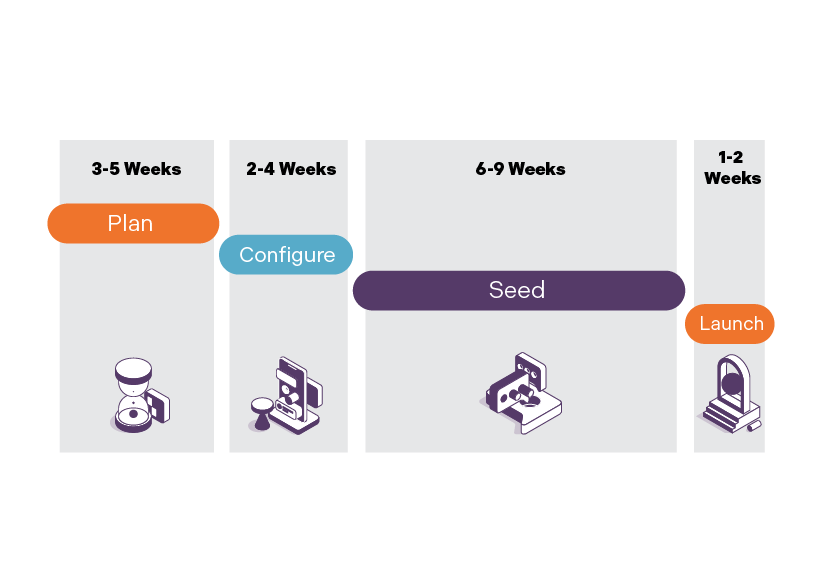During onboarding, you’ll work with a dedicated Ignition Consultant on a custom project plan to accomplish both your immediate and long-term knowledge goals.
Seamless Implementation & Onboarding
Dedicated Ignition Teams
We don’t leave you to set up Bloomfire on your own. We are here to help.
Customer Success Managers
Assigned to work with you throughout the ignition process.
Experts in Change Management
Will help you plan your adoption strategy to drive engagement.
Implementation Engineering
For complex builds that require a little additional help.
4 Step Ignition Sequence
Plan
Kick off your project by establishing your goals, key players and their roles, metrics you will use to measure progress, and mapping out your community and access group structure. Get training on how to use the platform to meet your goals.
Configure
Begin using the software and create your first community. Set up governance, operational settings, and categorization. Customize branding, choose color schemes, and set up your custom homepage.
Seed
Populate your community with content and ensure the platform works as expected; use beta testing to collect early feedback. Prepare teams for a successful launch.
Launch
Invite your users into the community and host a launch event. We will help you build and execute a change management plan.

Ignition Project Timelines
Successful adoption of a new platform can be challenging for your team. We are committed to making this the most successful launch in your company’s history. While some migrations can go much faster, a typical ignition project takes 12-20 weeks to complete. The seed phase is the largest time factor, where you begin to migrate content and train the authors and beta testers to prepare for a wider launch.
Key roles & effective change management
For a seamless implementation of Bloomfire’s platform, having the right stakeholders involved and an effective change management strategy in place is crucial. By delineating clear roles within your organization and fostering open communication, you can ensure the success of your knowledge management initiative.

Key Project Players
To help your project be successful we recommend you identify who in your organization will take on each of these critical roles:
Project Manager – your lead on the project and responsible for the ignition sequence launch plan.
Community Manager – responsible for long-term community management, including engagement initiatives, curation projects, reporting, and continuous improvement. This person will be responsible for maintaining the community standards post-launch.
Executive Sponsor – serves as the advocate for the community internally; usually, this is also who you will need to work with to manage the budget.
Internal Stakeholders – a cross-function committee that will provide feedback on the project plan, including content sources, community structure, user roles and permissions, and the launch plan.
Project collaborators – appointed by stakeholders. These individuals or teams will assist with the community, including IT, subject matter experts and content authors, beta testers, and others who will contribute to the success of your launch.

Change Management
We recommend a few key steps when setting up a new community to help prepare your users for a successful onboarding experience.
1. Survey the user base in advance. This helps identify pain points and set a baseline for the ROI metrics you will use to determine progress toward your goals.
2. Identify stakeholders by persona: Administrators, Moderators, Content Creators, and Content Consumers.
3. Engage senior leadership and executive sponsors throughout the process.
4. Plan company-wide communications through emails and other internal communications tools to both initial and future users.
5. Prepare training materials for each persona.
6. Host a live launch event (virtual or in person).
7. Set a follow-up training, office hours for experts, and a coaching schedule.
We are here to support you through every step of your onboarding experience. Our customer success team are change management experts and can share with you tools, templates, emails, surveys, training materials and self-service guides. We also have an open customer portal where knowledge managers and community leaders can ask questions from our team, see best practices and participate in peer learning.

Security & IT Setup
Depending on the information architecture of your security team, setting up Bloomfire’s user provisioning should take no more than 4 hours for your IT team. This time is primarily spent connecting SSO, if available, and configuring your SCIM setup. They also set up a vanity URL/subdomain for your team. They may need to add Bloomfire domains to your ‘allow’ lists on any internal firewalls. SCIM and vanity URLs are not requirements for using Bloomfire, but we are ready to deploy them to help make sure your community stays secure, and users have a flawless login experience on their first day.

User Roles
User Roles within the platform are defined as follows:
Owner: Customize community settings, edit community homepage, oversee billing information.
Administrator: Curate content, categories, and members. Send newsletters, create shared feeds, and view reporting.
Moderator: Approve/deny posts, series questions, and content. Review flagged contributions, edit any contributions across the community, manage meta-data, and make bulk changes.
Author: Submit posts, documents, and series. Comment on posts and series, ask and answer questions, and manage their content in bulk.
Learner: Search, browse, and discover content. Create personal feeds, bookmarks and subscribe to shared feeds, comment on posts and ask questions, like content, flag for review, or share with other members.

Start working smarter with Bloomfire
See how Bloomfire helps companies find information, create insights, and maximize value of their most important knowledge.

Take a self guided Tour
See Bloomfire in action across several potential configurations. Imagine the potential of your team when they stop searching and start finding critical knowledge.